慧点科技OA产品Indi Office V5白皮书
- 格式:pdf
- 大小:2.47 MB
- 文档页数:9
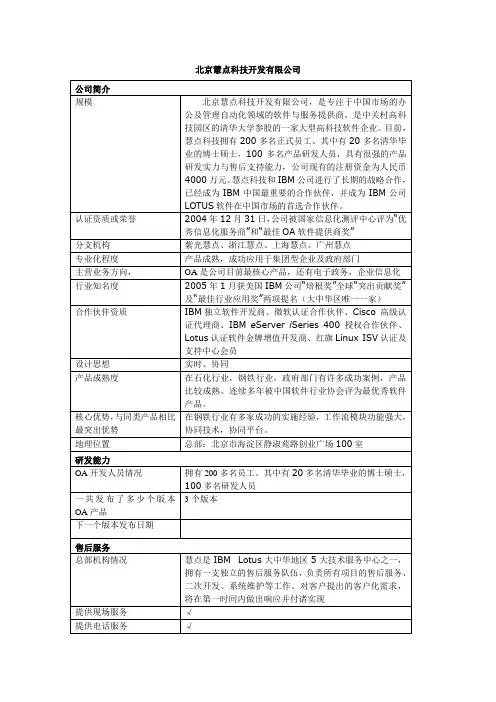
北京慧点科技开发有限公司地址:北京市海淀区上地东路1号盈创动力大厦A 座4层 电话:010- 第3页 邮编: 传真:010- 共11页发文管理 有独立开发的文件处理控件,支持浏览器上的发文审批的痕迹保留。
项目管理 对企业中众多的技改、建设项目的管理,包括项目任务的管理,项目资料、文件、成果的管理。
报表汇总统计 完善的报表管理可以对企业中其它的业务系统或者各分厂报送的报表进行数据处理,从中分类提起重要数据形成直观的数据图表,更便于集团公司领导决策。
办公助手单独进行的小软件,能够实现信息提示、邮件提醒等功能,并带有个性化页面。
产品的优势与不足 系统的特色模块 工作流模块,工作流定制工作流引擎 慧点用Java 开发的工作流定制模块,以图形化定制流程,方便,快捷。
系统的优势 慧点在石油、钢铁行业成功案例比较多,实施能力强 系统的不足 Lotus 系统对关系型数据库的访问能力比较差,对海量数据的处理与统计是弱项。
联系方式公司总部(北京)地址:北京市海淀区静淑苑路创业广场100室 邮编:电话:010-经营产品DCI.Indi.Office 3.0办公自动化系统 Indi.SiteManager 信息门户建设平台 Indi.Web 竞争情报分析系统 Indi.Image 扫描文档管理系统 Indi.Fax 企业级传真服务器DCI.Indi.Office 3.0办公自动化系统面向中大型的集团企业,作为项目开发平台,通过专业服务扩展,满足其在日常办公、业务等方面的需求。
Indi.SiteManager信息门户建设平台不要求操作者懂javascript、asp、jsp等网站编程语言和使用复杂的网页编辑工具,也不要求管理员会编写Domino的lotusscript代码,就可以完成界面管理、板块管理。
Indi.Web竞争情报分析系统Indi.Web互联网竞争情报分析系统凭借其优异的特色,使您的企业在竞争中脱颖而出!Indi.Image扫描文档管理系统为有效解决目前企业纸介质管理问题,慧点科技研发出了Indi.Image扫描文档管理系统。
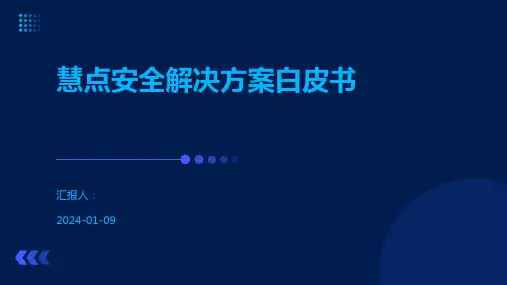
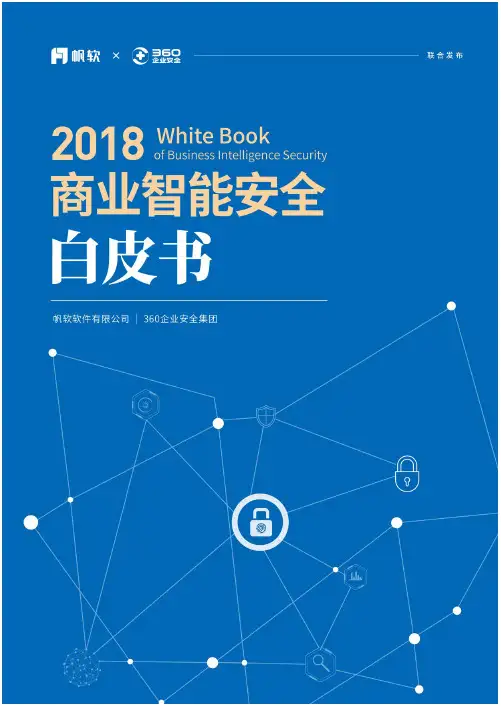
目录contents01/ 02/ 03/ 04/ 05/ 06/07/08/09/10/11/常见漏洞解决措施安全检测及评估指标安全管理策略及隐私典型的安全防护场景附录概述信息安全现状商业智能的安全总体策略设备及网络通信安全应用及数据安全移动端安全0305081013182123273033020101/概述依据《中华人民共和国计算机信息系统安全保护条例》(国务院147号令)、《国家信息化领导小组关于加强信息安全保障工作的意见》(中办发[2003]27号)、《关于信息安全等级保护工作的实施意见》(公通字[2004]66号)和《信息安全等级保护管理办法》(公通字[2007]43号)、《信息系统安全等级保护基本要求》(GB/T 22239-2008),制定本白皮书。
本白皮书是中国商业智能产品(以下简称BI产品)的安全标准参考指南,也是帆软商业智能系列产品(FineBI、FineReport)的安全框架和标准。
概述01本白皮书在现行通用的国内外安全技术类标准的基础上,主要参考《信息系统安全等级保护基本要求》,并根据国内外主流商业智能产品的技术标准和产品情况,提出了BI软件整体安全的保护要求规范,即安全管理策略和隐私、设备及网络通信安全、应用及数据安全、移动端安全,同时对帆软产品的安全特性及场景做了详细的说明。
本白皮书适用于企业评估选型商业智能产品,也适用于指导和规范帆软商业智能产品的规划、设计、交付和相关解决方案在安全领域的程序和标准。
03040605信息安全现状0202/信息安全现状信息安全是指为数据处理系统而采取的技术的和管理的安全保护,保护计算机硬件、软件、数据不因偶然的或恶意的原因而遭到破坏、更改、显露。
这里面既包含了层面的概念,其中计算机硬件可以看作是物理层面,软件可以看做是运行层面,再就是数据层面;又包含了属性的概念,其中破坏涉及的是可用性,更改涉及的是完整性,显露涉及的是机密性。
来自360、阿里巴巴、腾讯等互联网企业,以及公安部、工信部下属机构的监测数据显示:2016年监测到的企业信息安全事件数量已超过万起,较2014年增长了近十倍,且这些安全事件均给企业带来了不同程度的经济损失。
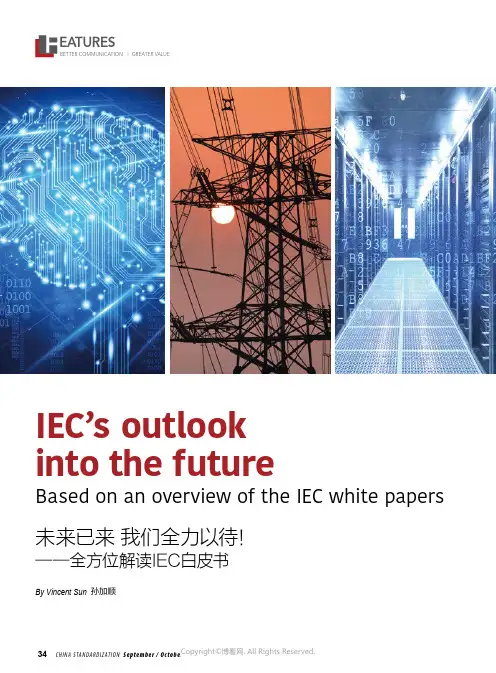
BETTER COMMUNICATION | GREATER VALUEIEC’s outlookinto the futureBased on an overview of the IEC white papers 未来已来 我们全力以待!——全方位解读IEC白皮书By Vincent Sun 孙加顺IEC is known as the home for industry and the “united nations of technologies” as the organization has been committed to the development of international standards for electric and electronic products, systems and services, collectively known as electrotechnology. Products and systems become increasingly sophisticated when technologies develop faster and faster, for which standards are playing a more vital role and embracing unprecedented challenges.Therefore, it is reasonable for this consensus body not only to solve existing problems in traditional arenas but also to look at the issues of emerging industries and future societies. Gathering leading minds of the industry, IEC has been closely focusing on the development trends of science and technology in a bid to update or develop standards for application of technological results, and the typical observations and prospects are published as white papers.As a form that differs from international standards, white papers together with technology reports at IEC are drafted and developed by the Market Strategy Board (MSB), which as one of the three pillar organs (Standardization Management Board, Market Strategy Board, Conformity Assessment Board) of the organization reports to the Council Board (CB) and identifies the principal technological trends and market needs in the IEC’s fields of activity.Portfolio of the IEC white papersAccording to the IEC, MSB is designated to set strategies to maximize input from primary markets and establish priorities for the technical and conformity assessment work of the IEC, improving its response to the needs of innovative and fast-moving markets. It may establish Special Working Groups (SWGs) under the leadership of a MSB member to investigate certain subjects in depth or to develop a specialized document. So far, the IEC/MSB has officially published 11 white papers and 2 technology reports.Grid integration of large-capacity Renewable Energy sources and use of large-capacity Electrical Energy Storage The Renewable and Sustainable Energy Institute (RASEI) at the University of Colorado at Boulder (CU-Boulder),the National Renewable EnergyLaboratory (NREL),State Grid Corporation of China (SGCC)Coping with the Energy Challenge The MSB Special WorkingGroup on electrical energyefficiency,the leadership of ClaudeBreining from SchneiderElectricEdge intelligence2017the MSB edge intelligenceproject team,Huawei,the Fraunhofer Institute for OpenCommunications Systems FOKUS2017LVDC: electricityfor the 21stcentury2013Nanotechnologyin the sectors ofsolar energy andenergy storage2014Orchestrating infrastructurefor sustainable Smart CitiesThe MSB project team on smartcities,Centre for European PolicyStudies (CEPS)Global energy interconnection2017The MSB global energyinterconnection projest team,the International EnergyAgency (IEA),State Grid Corporation ofChina (SGCC)2014Internet of Things: WirelessSensor NetworksThe MSB wireless sensornetworks project team,the US National Institute ofStandards and Technology (NIST),CTOs of leading internationalorganizationsMicrogrids for disasterpreparedness and recovery2014The MSB project team on microgriddisaster preparedness and recovery,the Commonwealth Scientific andIndustrial Research Organization ofAustralia (CSIRO),the Japanese National Institute ofAdvanced Industrial Science andTechnology (AIST)BETTER COMMUNICATION | GREATER VALUEFrom the above table, we can see that the white papers of the IEC focus around the key working areas of the organization, i.e. electrical energy, power storage and grid technology, future manufacturing and Internet of Things.The first white paper Coping with the Energy Challenge published in 2010 is believed to lay the foundation for the electrical energy efficiency discussion, with a model projecting to address the next 20 years based on the wide array of energy efficiency opportunities and technologies available. It summarizes situations for a roadmap for the international standardization to “enable highest short- and long-term energy efficiency outcomes, today and tomorrow”.This is followed by a series of white papers further road-mapping the technological and standards prospects on the storage, grid and interconnection of electricity. For example, Electrical Energy Storage summarizes “present and future market needs, reviews their technological features, and finally presents recommendations for all EES stakeholders” while the document also provides market guidance for the work of the IEC in support of this industry. Grid integration of large-capacity Renewable Energy sources and use of large-capacity Electrical Energy Storage specifically addresses the increasing presence and influence of renewable energies by looking at the grid integration technologies and difficulties at a global view.Microgrids for disaster preparedness and recovery is actually based on the risk-based mind by “encouraging the operation of microgrids and the implementation of standards to assist disaster relief planning”, to contribute to disaster preparedness and recovery in case of major electricity outage. Strategic asset management of power networks considers the necessity of international standards for power networks since this sector faces a period of profound change for such assets at different levels, ultimately relating to the secure supply of electrical energy. Global energy interconnection discusses the potential of global coordination and balance of electrical energy which can be highly complex and difficult, but fit for the needs of societal development.Other than electricity, the white papers show a natural inclination toward the prospects about the future of industry and infrastructure, which has also been the logical focus of the IEC to keep the system running with technological efficiency. Internet of Things, the future of the physical world, is obviously a priority for the technology circle. IEC publishes two white papers, Internet of Things: Wireless Sensor Networks and IoT 2020: Smart and secure IoT platform, addressing the application of WSNs and next generation platform-level technologies, both involving the discussion of standardization needs and plans. Smartness will be the core of both manufacturing and social operation. That’s why it is so important to employ standards to ensure efficiency and benefits for future cities and factories as highlighted in Orchestrating infrastructure for sustainable Smart Cities and Factory of the future.Contribution of the industryThe IEC family was joined by more than 20,000 experts from leading companies, institutes and organizations from around the globe. The experts not only share the cutting edge technological results and best practices, but also cooperate closely in a systematic and coordinated manner. What they do are also reflected in the development of white papers.Normally, there are projects or special working groups set up in the IEC/MSB for tracking and watching over specific areas of technological development. The white papers are prepared by such technical bodies, yet with enormous support from the industry, institutes and organizations.Those participating minds are ostensibly world-leading in those areas. For example, the Fraunhofer Institute standing for the cutting-edge technologies contributes to the development of Electrical Energy Storage, Factory of the future and Edge intelligence. State Grid Corporation of China (SGCC) standing for the national grid maintainer has provided support in the documentation of Grid integration of large-capacity Renewable Energy sources and use of large-capacity Electrical Energy Storage and Global energy interconnection.Other industry giants like Schneider Electric and Huawei also contribute to the white papers based on their advantages. Experts from national or international organizations have played a vital role in addressing issues concerned in their respective areas. The participation into such cooperation somehow reflects the technological strengths and global influence of different countries or organizations.IEC’s outlook into the futureThe above analysis may shed a light on the prospects of this international organization that the future of industry and society will still have to do with two major pillars, energy and communication, both posing challenges for the infrastructure preparedness.For the future, according to the white papers, the increasing population and expanding urban population will mean more pressure on energy and related infrastructure. Resilience and sustainability will be considered the core principles for the environment of human development. Technology will provide potential paths for addressing existing or emerging issues.Standards are considered the fundamental layer basis for systems. In the system of a factory or even a city, standards play a central role in ensuring the coordination and interoperability. With technology progressing faster, international standards become even more important for the emerging global interconnection. IEC as an international organization possesses the capability and bears the responsibility to contribute to making the world a better place to live.From the white papers, we can see the future through the intelligent prospects of the IEC.Reference:1. https://www.iec.ch/whitepaper2. IEC white papers & technology reports。

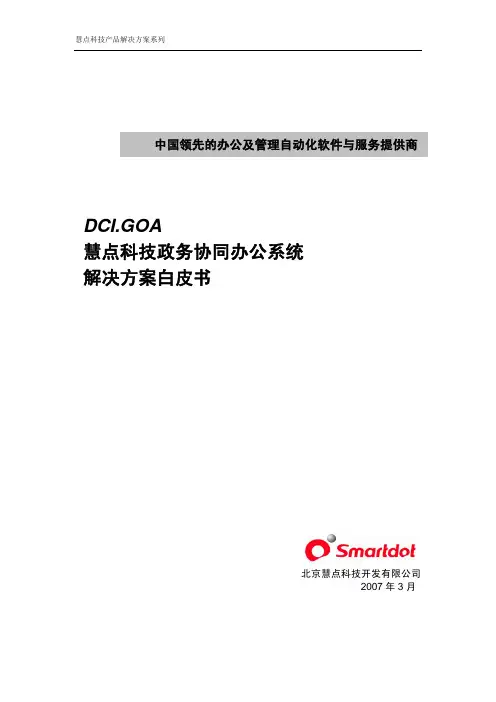
中国领先的办公及管理自动化软件与服务提供商DCI.GOA慧点科技政务协同办公系统解决方案白皮书北京慧点科技开发有限公司2007年3月目录一、方案背景 (1)二、设计思想 (1)三、总体设计 (2)四、系统功能设计 (4)4.1领导桌面 (4)4.2通用办公系统 (4)4.3业务办公系统 (9)4.4公文交换系统 (10)4.5门户平台 (11)4.6单点登录 (12)4.7政务移动办公 (12)4.8 CA接口 (13)五、系统特点 (13)六、应用价值 (15)1应用上重“一体” (16)2操作上重“三用” (16)3实现上重“六化” (17)七、典型案例 (18)7.1国家新闻出版总署电子政务一期工程 (18)7.2广西南宁市电子政务一期工程 (21)7.3北京市市直机关工作委员会信息管理系统 (21)7.4武夷山市政府“数字武夷”电子政务工程 (23)一、方案背景慧点科技GOA政务协同办公系统是一个以办公管理为核心的、互联互通和资源共享的综合办公系统。
在满足政府部门办公业务处理和个性化功能要求的基础上,通过统一安全的接口系统,最终形成一个大型分布式网络办公应用系统。
GOA政务协同办公系统的作用在于整合政府资源,加快信息流通,规范办公流程,提高办公效率,降低办公成本。
她通过尖端信息技术与先进管理理念的融合应用,将人从繁琐、无序、低端的工作中解放出来从事核心事务,降低办公成本,提高管理水平。
GOA政务协同办公系统能够覆盖全部政府机构,横向到边、纵向到底,最终实现部门与部门之间,系统与系统之间的协同办公,从而提高办公效率,并实现资源的共享。
系统解决了用户内部的各部门及岗位间的协同,上下级间的沟通,以及信息资源的管理和利用。
同时,加强了上级对下级、总部对分支的监控,并利用不断积累的信息资源辅助领导决策。
二、设计思想慧点科技按照国家电子政务工程建设的相关要求,结合我国政府自身的特点,采用信息化技术,为政府的办公业务管理和事务处理,提供了一个数字化工作环境。
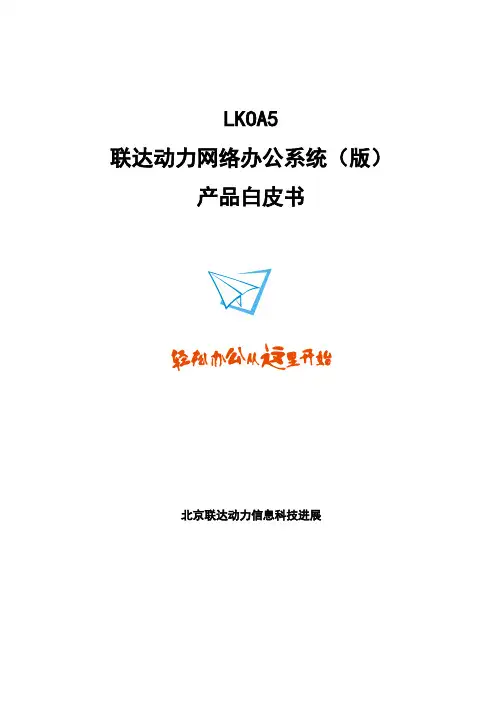
LKOA5联达动力网络办公系统(版)产品白皮书北京联达动力信息科技进展版权申明及利用许可2000年-2004年北京联达动力信息科技进展本软件产品及本软件产品的任何副本的产权及高作权均属北京联达动力信息科技进展所有。
您不得利用任何工具或任何软件对本软件产品进行反向编译或反汇编。
未经联达动力公司许可,不得以任何目的和方式发布或利用本软件产品或其相关资料的部份及全数内容。
若是任何组织或任何个人以任何形式进行本软件产品或相关资料的违法发布或利用,联达动力公司均保留依照中华人民共和国相关法律对其进行严厉的民事及刑事追究的合法权利。
上述本软件产品及相关资料包括:本软件的程序(包括源代码)、附加程序(包括源代码)、图片、动画、录象、录音、文字、宣传介绍材料。
北京联达动力信息科技进展联系方式地址:北京市宣武区南滨河路23号立恒名苑2号楼1805室:100055总机:86-/61/62/63:86-公司网站:电子邮件:目录一、整体介绍....................................................................... 错误!未定义书签。
二、系统特点....................................................................... 错误!未定义书签。
三、系统原理及体系架构................................................... 错误!未定义书签。
1.LKOA5网络工作原理图 ............................................ 错误!未定义书签。
2.LKOA5组件装配原理图 ............................................ 错误!未定义书签。
四、系统功能介绍(核心功能)....................................... 错误!未定义书签。
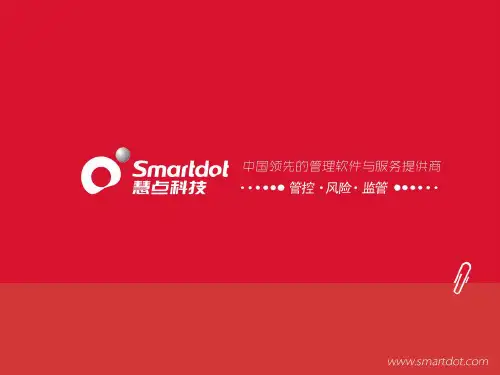
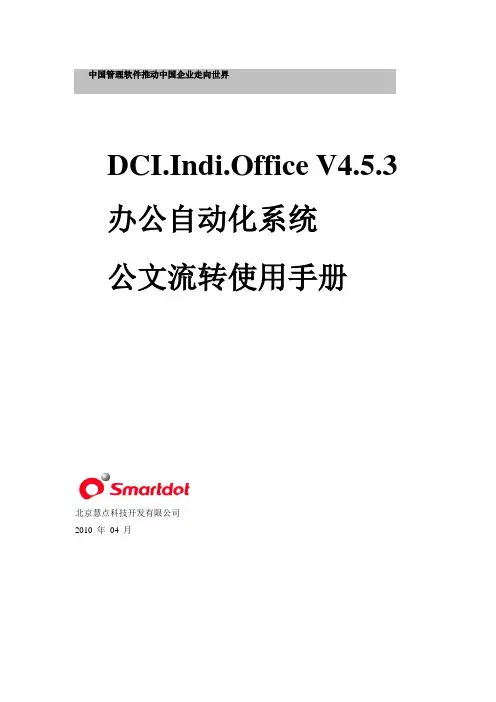
北京慧点科技开发有限公司2010 年 04 月中国管理软件推动中国企业走向世界 DCI.Indi.Office V4.5.3办公自动化系统公文流转使用手册1.公文配置(1)功能描述用来生成和配置部门公文库,并对配置信息进行管理。
操作公文之前,系统管理员必须在【公文配置】里先定义部门流程库,发文库,收文库并为其指定公文文书,然后公文文书才能定义本部门的流程,开始公文流转。
至于催办提醒,签字库,密钥管理,待办事宜及公文统计模块都是与公文流转业务相关的模块,并不是公文流转的前提条件。
在[配置中心]中将办公系统配置下的Key_multidomain的关键字的值设为true,公文配置中便可以对多网络域的分子公司以及分子公司部门设置。
(注:分子公司以及发子公司部门是多个OA系统间进行公文收发时使用,如甲公司OA发文到乙公司收文,两个OA的公文配置库都要创建相关的配置文档。
跨应用的收发文的工作将通过OA消息引擎来完成)(2)操作过程(2-1)新建公文配置表点击导航条中的“公文配置”进入部门公文配置页面如图1-1,选择点击左侧部门后即打开被选部门下的配置文档:图1-1点击右上角的“新建”按钮,打开被选部门的配置界面。
如下图1-2:图1-2“应用名”:默认为部门所在应用。
在“数据库类别”里,勾选某项操作后,“模板库文件名”、“数据库中文名”、“数据库文件名”等信息会自动列出;并可查看已有其他数据库信息,若要编辑已有数据库,可打开编辑图1-1所示视图中的对应文档。
“模块分类”指定生成的库放在哪个目录下显示。
注:创建数据库类别一般采用如下顺序比较合适,文档一体化->流程定义-发文管理-收文管理-请示报告“数据库中文名”和“数据库文件名”只要选择了“数据库类别”后,就会自动生成名称,这些名称也可以更改或手动输入。
“文件归档到”制定该公文在点击“归档”操作后,文档在指定的“文档一体化库”里创建一个复本,复本在文档一体化“未分类视图”下,由指定的部门管理员(文书)用户来分类管理,其它用户可以借阅文档。
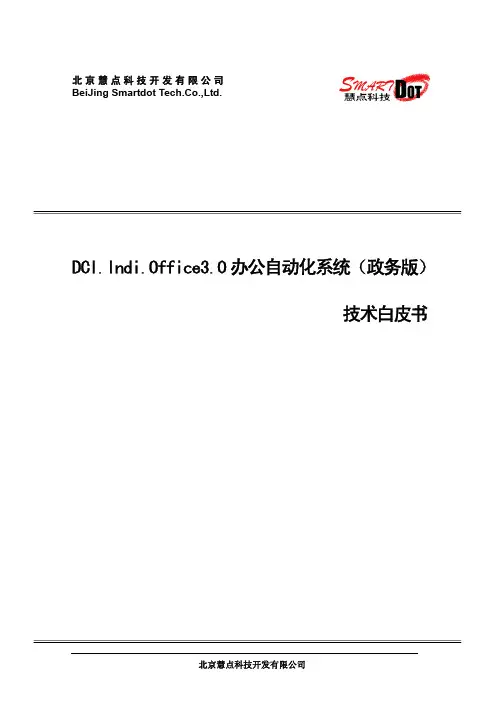
北京慧点科技开发有限公司BeiJing Smartdot Tech.Co.,Ltd.DCI.Indi.Office3.0办公自动化系统(政务版)技术白皮书目录第1章引言 (3)1.1 背景 (3)1.2 系统目标 (4)第2章系统概述 (5)2.1 预期读者 (5)2.2 系统特点 (5)2.3 系统架构特点 (7)2.3.1 功能特点 (7)2.3.2 技术特点 (7)2.4 总体架构 (8)2.4.1 单应用架构 (8)2.4.2 多应用架构 (9)第3章运行环境 (10)第4章系统性能 (10)4.1 稳定性 (10)4.2 系统资源消耗 (10)4.3 系统并发访问性能 (11)4.4 页面响应时间 (11)第5章系统功能模块清单 (11)第6章公司简介..................................................................................................错误!未定义书签。
第1章引言1.1 背景在1995 年初国家和企业虽然也对办公自动化OA 进行了大量的人力和物力投入,但那时还仅仅是停留在提高个人的办公效率上,例如将手工打印转移到电脑打印,或是利用简单的数据库软件编写程序来建立员工档案数据,查找内部信息。
然而办公自动化的本质是提高机关或是企业办公的整体效果。
而能够将整体办公性能进行提高的,就只有在符合CSCW(Computer Supported CooperativeWork,电脑化协同工作)意义下开发的办公管理套件系统才能够做到。
当今办公的现状是信息量越来越大、信息更新的节奏越来越快、越来越多的办公对象不再仅仅是面对数据,而是面对文档,甚至还有多媒体信息、随着企业规模的不断扩大,异地办公的模式也越来越普遍。
因此要想达到具有CSCW 意义的协同工作办公系统,没有计算机以及网络的支持就很难得以实现。
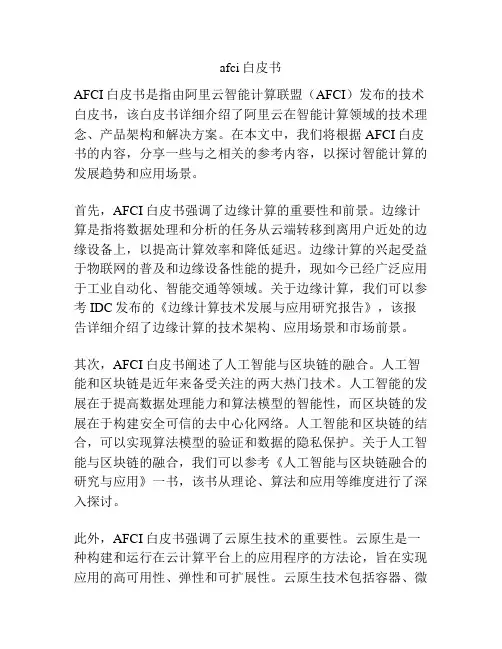
afci白皮书AFCI白皮书是指由阿里云智能计算联盟(AFCI)发布的技术白皮书,该白皮书详细介绍了阿里云在智能计算领域的技术理念、产品架构和解决方案。
在本文中,我们将根据AFCI白皮书的内容,分享一些与之相关的参考内容,以探讨智能计算的发展趋势和应用场景。
首先,AFCI白皮书强调了边缘计算的重要性和前景。
边缘计算是指将数据处理和分析的任务从云端转移到离用户近处的边缘设备上,以提高计算效率和降低延迟。
边缘计算的兴起受益于物联网的普及和边缘设备性能的提升,现如今已经广泛应用于工业自动化、智能交通等领域。
关于边缘计算,我们可以参考IDC发布的《边缘计算技术发展与应用研究报告》,该报告详细介绍了边缘计算的技术架构、应用场景和市场前景。
其次,AFCI白皮书阐述了人工智能与区块链的融合。
人工智能和区块链是近年来备受关注的两大热门技术。
人工智能的发展在于提高数据处理能力和算法模型的智能性,而区块链的发展在于构建安全可信的去中心化网络。
人工智能和区块链的结合,可以实现算法模型的验证和数据的隐私保护。
关于人工智能与区块链的融合,我们可以参考《人工智能与区块链融合的研究与应用》一书,该书从理论、算法和应用等维度进行了深入探讨。
此外,AFCI白皮书强调了云原生技术的重要性。
云原生是一种构建和运行在云计算平台上的应用程序的方法论,旨在实现应用的高可用性、弹性和可扩展性。
云原生技术包括容器、微服务框架和自动化运维工具等。
关于云原生技术,我们可以参考《云原生技术与实践》一书,该书介绍了云原生技术的基本概念、原理和实践案例,有助于我们深入了解云原生的应用和发展。
最后,AFCI白皮书提到了基于AI的物联网技术。
物联网(Internet of Things, IoT)是指将传感器、设备和其他物理实体通过互联网互相连接,形成一个网络,实现设备之间的信息交互和智能控制。
基于AI的物联网技术能够通过感知、识别和推理等能力,实现对物理世界的智能感知和智能决策。
慧点科技合同产品分析
1、在采用了Xpage开发框架的基础上,Indi.Platform通过优化的分层架构模式支撑了更多的并发用户访问量,满足集中大用户量应用的要求;
2、Indi.Platform进一步提高了运算能力,满足高性能统计和信息检索需求;
3、Indi.Platform降低了对用户硬件资源,尤其是存储的要求;
4、Indi.Platform提升了用户总体的安全保障;
5、与office的无缝集成,为法务工作提供依据;
6、灵活的工作流定制,减少后期系统的维护费用;
7、通过固化合同的审核要素,落实内控管理要求,降低合同风险;
8、强大的权限控制功能,保证合同的保密性、安全性。
【信息化-精编】通软iOA产品⽩⽪书通软iOA产品⽩⽪书创新通软iOA产品⽩⽪书版本:2.1⽬录1为什么需要办公⾃动化(OA)系统42(分析调研)当前市⾯OA产品⾯临的实施障碍53创新通软IOA的产品优势94IOA产品的核⼼价值介绍114.1I OA⾯向电⼦⽂档管理进⾏全⾯优化124.2I OA具有B/S体系结构,满⾜异地办公需求144.3I OA保证100%实施,数据和功能按需分配和实施144.4I OA通过门户整合业务信息⽬录(栏⽬),⼤⼤提⾼信息可⽤性15 5IOA产品的有效实施保证166IOA产品的突出技术卖点196.1⽆处不在的强⼤多媒体W EB编辑器206.2多种决策模式的⽀持和实现216.3捆绑RTX,MSN和短信猫,打造实时组织226.4图形化⼯作流定义和执⾏指⽰236.5多语⾔版本,满⾜多⽂化的融合246.6基于/doc/34d23b9c00f69e3143323968011ca300a7c3f692.html 的动态门户技术,信息按需整合24 6.7全新.NET⼿写批注控件,更安全、更稳定256.8全⾯整合W INDOWS活动⽬录管理(AD)266.9⽀持全⽂查找、不同类型的附件全⽂查找267IOA产品的服务流程和资源277.1I OA产品提供的售前⽀持287.2I OA产品提供的售中服务297.3I OA产品提供的售后服务298(参数)产品的版本、功能定位和报价308.1I OA的产品功能参考348.2I OA产品报价399感谢您关注IOA产品!421为什么需要办公⾃动化(OA)系统随着信息化建设的⽇益深⼊,⽆论是政府还是企事业单位,相互之间的信息沟通与协同⼯作越来越重要。
在地域上,每个单位都希望能和异地的分⽀机构、上下级部门等保持实时联系,希望⾃⼰⾝处异地仍能了解和处理单位事务。
在信息获取上,每个单位希望各种业务信息能按需整合,为员⼯和领导的⽇常办公和业务决策提供有效的信息。
慧点安全解决方案白皮书二十一世纪是信息化世纪,随着网络技术的进展,专门是Internet的全球化,信息共享的程度进一步提高。
数字信息越来越深入的阻碍着社会生活的各个方面,各种基于互联网技术的网上应用,如电子政务、电子商务等也得到了迅猛进展。
网络正逐步成为人们工作、生活中不可分割的一部分。
由于互联网的开放性和通用性,网上的所有信息对所有人差不多上公布的,因此网络上的信息安全问题也日益突出。
目前政府部门、金融部门、企事业单位和个人都日益重视这一重要问题。
大、中型企业如何爱护信息安全和网络安全,最大限度的减少或幸免因信息泄密、破坏等安全问题所造成的经济缺失及对企业形象的阻碍,是摆在我们面前亟需妥善解决的一项具有重大战略意义的课题。
网络的飞速进展推动社会的进展,大批用户借助网络极大地提高了工作效率,制造了一些全新的工作方式,专门是因特网的显现更给用户带来了庞大的方便。
但另一方面,网络,专门是因特网存在着极大的安全隐患。
近年来,因特网上的安全事故屡有发生。
连入因特网的用户面临诸多的安全风险:拒绝服务、信息泄密、信息篡改、资源盗用、声誉损害等等。
类似的风险也存在于其它的互联网络中。
这些安全风险的存在阻碍了运算机网络的应用与进展。
在网络化、信息化的进程不可逆转的形势下,建立安全可靠的网络信息系统是一种必定选择。
为此,慧点科技以PKI为核心,配合PMI能够有效地解决信息安全问题,从而确保网上信息的保密性、完整性、防抵赖性,以及信息来源的可靠性,为各企事业单位的信息化建设与实施提供了卓有成效的安全防护。
一.慧点产品总体框架慧点科技致力于为企事业单位提供完整的电子政务、电子商务核心解决方案,构建平台统一、系统安全、投资合理、运行高效的系统平台,提供服务于应用集成、数据集成和表现集成的全线产品,为企事业单位信息化构建动态协同的基础设施。
慧点科技的办公系统满足企事业单位日常办公的各种业务需要,是政府、企业信息化的基础应用系统;数据交换平台提供各系统间的业务集成,是企事业单位实施全方位信息化和数据共享的基础中间件平台;一站式服务平台实现政府跨部门的网上行政、网上办公和网上审批,是实现阳光行政、高效行政、依法行政的关键平台;统一信息门户提供丰富的内容表现方式、全方位的访问接入方式和个性化服务,是企事业单位信息化的统一入口,是领导决策的信息来源,是政府、企业的形象的集中表现。
慧点科技解决方案概述慧点科技解决方案概述慧点科技在对国内企业内控需求的理解以及在对COSO报告充分了解的基础上,推荐采用IBM的WBCR产品建立与完善企业的内部控制系统。
该产品定位于企业内部控制企业内部控制的本质是为了加强企业对其商业流程以及风险的识别、管理、控制以及报告,从而做到对内,规范管理、加强监控、建立企业问责机制;对外,对投资人、客户以及合作伙伴负责,提升企业诚信度;规避各种商业运营风险;满足相关法案强制要求。
IBM软件平台的定位及核心功能IBM提供的以IWBCR (IBM Workplace for Business Control and Reporting)为核心的软件平台,致力提供企业高效率、高效力、低成本的内部控制机制解决方案IWBCR提供一个标准平台用于帮助各大公司解决诸多业务控制相关的问题;IWBCR的设计目的是帮助公司实现Sarbanes Oxley遵从与一般控制管理相统一,从而不必创建过多的分离系统;IWBCR支持开放式控制环境,包含了来自COSO的综合控制框架,IT管理协会的CobiT 内部控制框架以及其它内部控制框架;IWBCR为企业实施业务风险管理框架提供牢固的基础;IWBCR与传统的决策分析工具(比如某个用户、某项产品和市场分析等)相结合使用时,风险管理将为决策者提供更为广阔的前景。
IWBCR可以为企业创建一个内部控制的基础依托环境,从而帮助企业展开如下活动第3章IBM WBCR软件的主要优势 3.1 从业务角度遵从法案该产品紧密结合企业内控要求,集成KPMG建议,遵从COSO框架及COBIT框架,引导公司内控工作,涵盖并管理文档记录、测评、评估、改进、测试等阶段的工作;产品的成熟度IBM作为进入企业内控管理领域较早的IT厂商,IWBCR产品的最新版本为2.6,并于年底前推出3.0版本;强大的文档管理能力该产品可进行文档收集,并对收集的文档进行检索查询、共享、存贮备份等操作。
IndiOffice安装文档安装准备在安装应用配置之前,必须确定以下几件事情:1、Domino服务器的版本是R6.5.4以上;2、服务器安装完成,并且未作其它的应用开发;3、服务器都已启动;4、正在使用的Notes客户端配置完成,可以正常的连接到服务器上。
5、确认安装Domino服务器时选择的服务器端口网络地址为IP地址形式或DNS可解析的域名形式,如果为Domino主机名形式,则需要在Host文件的IP地址后添加此主机名进行解释,否则可能出现用户注册不成功等现象(安装后可以在服务器管理端的服务器配置文档的端口页面下查看当前设置);6、确认运行Indioffice安装程序的用户id对服务器文档有修改权限;然后将慧点所提供的安装包中的所有数据库模板,放到该Notes客户端所在电脑的文件系统中,用管理员ID对其进行签名;随后即可进行安装配置。
安装程序简介在notes客户端打开oainstall.ntf数据库,进入Indi.Office4.5.3系列安装程序。
如图:图-1界面上有两个按钮:【开始安装】和【模块配置】,这也是安装程序的两个主要的功能。
点击【开始安装】按钮,就可以按照提示一步一步的将Indi.Office系统安装到Domino服务器上;主应用的安装配置1、在安装程序首页面上点击“下一步”,即启动Indi.Office4.5.3安装过程,也可以点击“安装必读”查看安装时注意的问题。
图-32、确认页面中提示的几点事项后,点击【下一步】按钮。
如果没有对安装包中的模板进行签名,则出现如下的“执行安全性警报”,单击【信任签名者】即可。
图-43、选择“主应用”选项,点击【下一步】。
图-54、在下拉列表中选择需要安装主应用的服务器(注:服务器名称必须带组织名并填写完整,否则安装程序用服务器id签名时会不成功)。
如果在服务器列表中没有主应用的服务器名称,也可手工输入。
点击【下一步】。
图-65、根据提示填写主应用的相关信息(应用路径、应用名称),点击【下一步】。